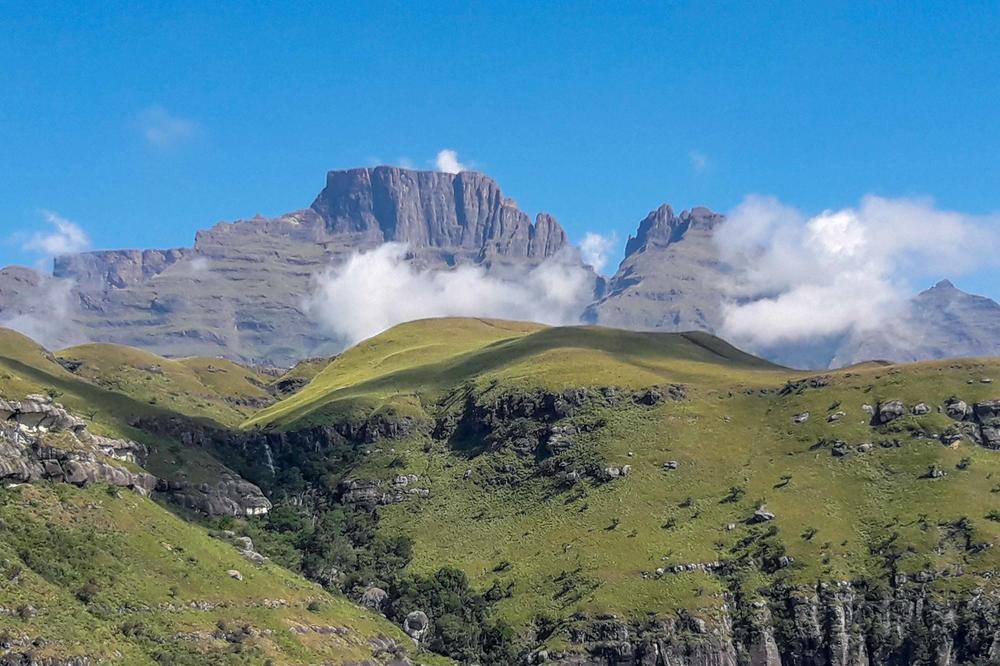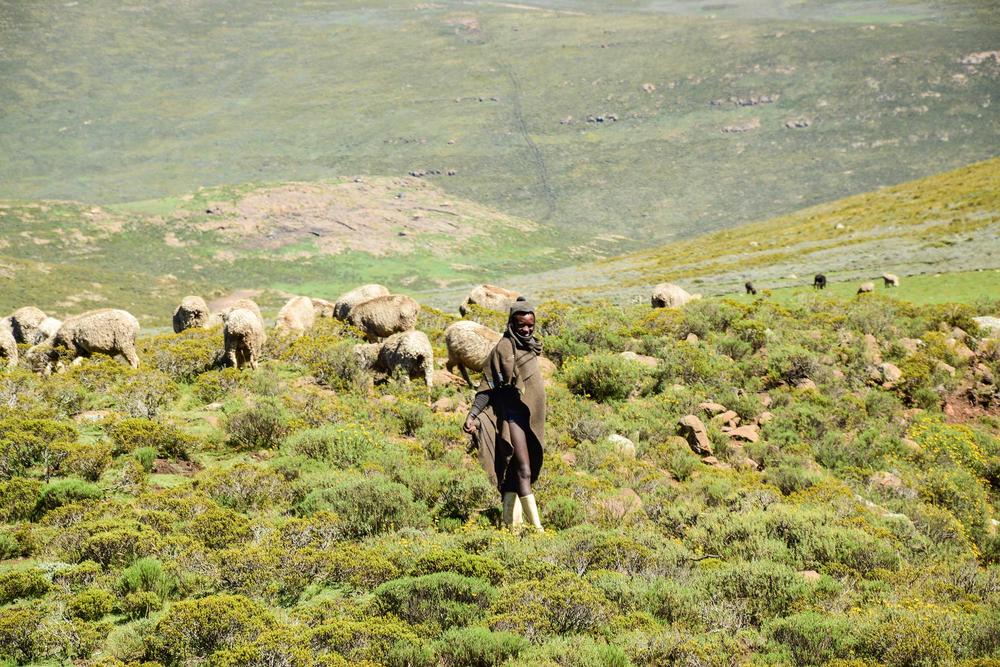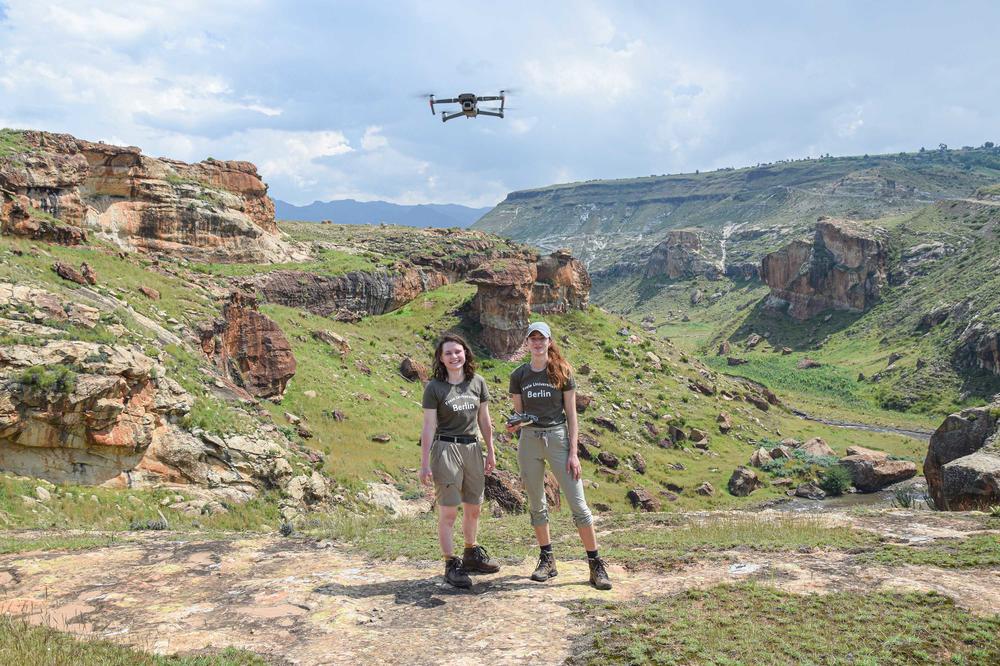The Mystery of Lesotho
Researchers want to prove that the plateau in Lesotho was not glaciated during the last ice age, which ended about 12,000 years ago
Jun 09, 2022
The approximately 3,500-meter-high portion of the Great Escarpment known as Drakensberg is primarily made up of layers of basalt rock. The research team there is studying fossil remains of fish and snails, bringing new insights into the last ice age.
Image Credit: Frank Riedel
The drone, controlled by doctoral researcher and pilot Venise Gummersbach, glides gently over a bluff on the lookout for traces of glaciation during the ice age. Suddenly, a warning cry is heard. “Eagle!” shouts copilot Jana Frenzel. Gummersbach steers the drone clear at the last moment, missing the bird of prey as it darts up to protect its nest. Bird attacks by eagles and swallows pose the greatest danger for Gummersbach’s research drone in the scarcely explored highlands of Lesotho, a landlocked country surrounded by the Republic of South Africa.
Together with master’s student Jana Frenzel and a team including paleontologist Frank Riedel and geographer Kai Hartmann from Freie Universität Berlin, she wants to prove that the plateau in Lesotho was not glaciated during the last ice age, which ended approximately 12,000 years ago, and that the reason was not due to lack of water, as assumed by some researchers, but excessively high temperatures.
Erosion poses a threat to the region as more and more animals graze on the high mountain slopes and trample the grasslands, causing water to drain more quickly and depleting the reservoir.
Image Credit: Kai Hartmann
How Is Climate Change Impacting the Region?
The research team includes isotope paleontologist Ulrich Struck from the Museum für Naturkunde – Leibniz Institute for Evolution and Biodiversity Science and the zoologist and biogeographer Christian Albrecht from Giessen University. Their work is being funded by the German Research Foundation (Deutsche Forschungsgemeinschaft) and the Research Commission of Freie Universität Berlin and may be relevant in assessing the effects of climate change on the water supply in the southern part of Africa.
The highlands of Lesotho are a natural water tower that has probably supplied water to southern Africa for millions of years. It is a spring for the largest river in the region, the Orange River – or Senqu River, as the part of it that runs through Lesotho is known – which today supplies water to millions of people for farming and other uses.
For them, it could spell trouble if the highlands in Lesotho are shown to have been too dry for rivers in the past. Because what happened once could happen again – an alarm signal perhaps for the potential consequences of future climate change in the region.
However, the team subscribes neither to the hypothesis of water shortage nor to that of glaciation. Riedel, Gummersbach, and the other project participants want to prove that rivers originated during the last ice age in what were supposedly the dry highlands of Lesotho. They believe that the fossil remains of fish prove that it was too warm for glaciers in the highlands, even during the last ice age. As drone images taken by Gummersbach show, what was previously assumed to be the remnants of glaciers might actually have a different origin.
The team also achieved an additional success. Project partner Christian Albrecht proved that snails inhabited the rivers for thousands of years, evidence that the highlands of Lesotho have provided water at least since then. This finding might seem to provide a tentative sense of relief when thinking about how climate change will impact the future.
Pasture Farming Is a Growing Problem
Gummersbach is cautious about the current state of research, pointing to new threats to the water reservoir in Lesotho identified by the team on the ground. However, the greatest danger is probably the ever-increasing amount of livestock farming. A growing number of cattle and sheep graze on and trample the green grasses of the wetlands and high mountain slopes, which threatens further erosion. Left unchecked, water could then run off more quickly, emptying the natural reservoir. In addition, animal excrement would pass through plants into the groundwater unfiltered.
Despite their knowledge of the perils of pasture farming, the research team does not view the herders in the highlands as a problem. On the contrary, their encounters with the locals were friendly. “The herders often joined us, shared apricots with us, or took the apples we gave them,” says Gummersbach. The herders were grateful to receive the team’s culinary novelties in the austere highlands, and were especially interested in the drone. Gummersbach showed the herders how the drone worked and allowed them to watch her operate it and follow along on the control screen. “Sometimes so many people gathered around the screen that I could barely operate the drone,” she recalls.
The drone keeps everything in sight. Master’s student Jana Frenzel (left) and doctoral candidate Venise Gummersbach are part of the research team with paleontologist Frank Riedel and geographer Kai Hartmann.
Image Credit: Kai Hartmann
The drone was financed by grants reserved specifically for female researchers at Freie Universität Berlin, and especially those working to earn their doctorates and become professors. Frenzel and Gummersbach took advantage of the opportunity.
With their findings in Lesotho, the Berlin-Giessen team plans to apply for additional grant funding through 2025 from the German Research Foundation. If this is approved, Gummersbach, who currently receives doctoral funding through the Protestant Student Union Villigst (Das Evangelische Studienwerk Villigst), could then be offered a research position on the Lesotho project, and Frenzel would have the opportunity to begin her doctoral thesis.
An Innovative Approach to Tracing the Climate History of a Region
The project would lead to further scientific discoveries and greater public knowledge about the Lesotho highlands, which have barely been explored, but are so crucial for the water supply for all of southern Africa. In any case, the team is determined to illustrate climate change in the region based on evidence such as stalagmites or lake sediment that might have preserved historical climate-related information – sources of information that other researchers have not typically investigated to date.
With their innovative, interdisciplinary approach that includes the use of a drone, Gummersbach and her team of colleagues show that they can overcome obstacles, even an eagle in attack mode.
This article originally appeared in German on May 8, 2022, in the Tagesspiegel newspaper supplement published by Freie Universität Berlin.



